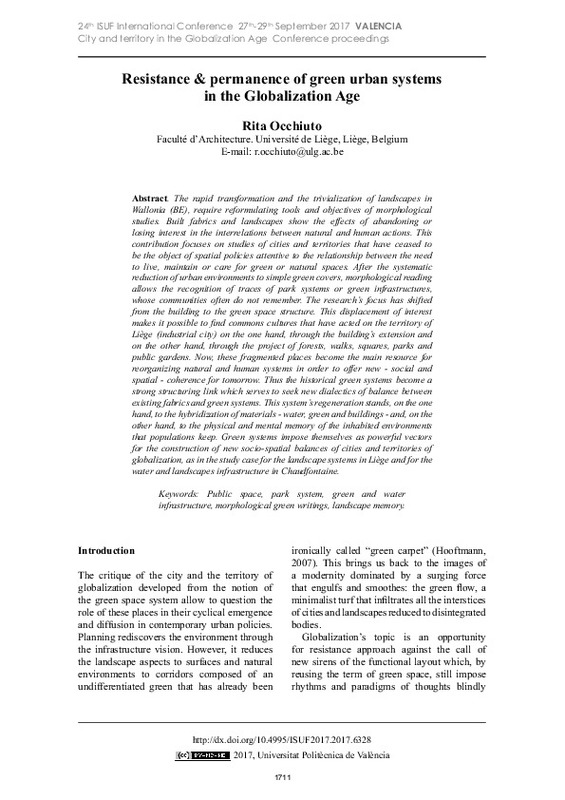JavaScript is disabled for your browser. Some features of this site may not work without it.
Buscar en RiuNet
Listar
Mi cuenta
Estadísticas
Ayuda RiuNet
Admin. UPV
Resistance & Permanence of Green Urban Systems in the Globalization Age
Mostrar el registro sencillo del ítem
Ficheros en el ítem
| dc.contributor.author | Occhiuto, Rita
|
es_ES |
| dc.coverage.spatial | east=4.451006600000028; north=50.4175637; name= Wallonia, Bèlgica | es_ES |
| dc.date.accessioned | 2018-12-28T07:50:27Z | |
| dc.date.available | 2018-12-28T07:50:27Z | |
| dc.date.issued | 2018-04-20 | |
| dc.identifier.isbn | 9788490485743 | |
| dc.identifier.uri | http://hdl.handle.net/10251/114550 | |
| dc.description.abstract | [EN] The rapid transformation and the trivialization of landscapes in Wallonia (BE), require reformulating tools and objectives of morphological studies. Built fabrics and landscapes show the effects of abandoning or losing interest in the interrelations between natural and human actions. This contribution focuses on studies of cities and territories that have ceased to be the object of spatial policies attentive to the relationship between the need to live, maintain or care for green or natural spaces. After the systematic reduction of urban environments to simple green covers, morphological reading allows the recognition of traces of park systems or green infrastructures, whose communities often do not remember. The research's focus has shifted from the building to the green space structure. This displacement of interest makes it possible to find commons cultures that have acted on the territory of Liège (industrial city) on the one hand, through the building’s extension and on the other hand, through the project of forests, walks, squares, parks and public gardens. Now, these fragmented places become the main resource for reorganizing natural and human systems in order to offer new - social and spatial - coherence for tomorrow. Thus the historical green systems become a strong structuring link which serves to seek new dialectics of balance between existing fabrics and green systems. This system’s regeneration stands, on the one hand, to the hybridization of materials - water, green and buildings - and, on the other hand, to the physical and mental memory of the inhabited environments that populations keep. Green systems impose themselves as powerful vectors for the construction of new socio-spatial balances of cities and territories of globalization, as in the study case for the landscape systems in Liège and for the water and landscapes infrastructure in Chaudfontaine. | es_ES |
| dc.format.extent | 8 | es_ES |
| dc.language | Inglés | es_ES |
| dc.publisher | Editorial Universitat Politècnica de València | es_ES |
| dc.relation.ispartof | 24th ISUF International Conference. Book of Papers | es_ES |
| dc.rights | Reconocimiento - No comercial - Sin obra derivada (by-nc-nd) | es_ES |
| dc.subject | Public space | es_ES |
| dc.subject | Park system | es_ES |
| dc.subject | Green and water infraestructure | es_ES |
| dc.subject | Morphological green writings | es_ES |
| dc.subject | Landscape memory | es_ES |
| dc.title | Resistance & Permanence of Green Urban Systems in the Globalization Age | es_ES |
| dc.type | Capítulo de libro | es_ES |
| dc.type | Comunicación en congreso | es_ES |
| dc.identifier.doi | 10.4995/ISUF2017.2017.6328 | |
| dc.rights.accessRights | Abierto | es_ES |
| dc.description.bibliographicCitation | Occhiuto, R. (2018). Resistance & Permanence of Green Urban Systems in the Globalization Age. En 24th ISUF International Conference. Book of Papers. Editorial Universitat Politècnica de València. 1711-1718. https://doi.org/10.4995/ISUF2017.2017.6328 | es_ES |
| dc.description.accrualMethod | OCS | es_ES |
| dc.relation.conferencename | 24th ISUF 2017 - City and Territory in the Globalization Age | es_ES |
| dc.relation.conferencedate | Septiembre 27-29,2017 | es_ES |
| dc.relation.conferenceplace | Valencia, Spain | es_ES |
| dc.relation.publisherversion | http://ocs.editorial.upv.es/index.php/ISUF/ISUF2017/paper/view/6328 | es_ES |
| dc.description.upvformatpinicio | 1711 | es_ES |
| dc.description.upvformatpfin | 1718 | es_ES |
| dc.type.version | info:eu-repo/semantics/publishedVersion | es_ES |
| dc.relation.pasarela | OCS\6328 | es_ES |








